

Vertebrata Palasiatica ›› 2025, Vol. 63 ›› Issue (2): 102-132.DOI: 10.19615/j.cnki.2096-9899.250417
Previous Articles Next Articles
WANG Ban-Yue( ), QIU Zhu-Ding, LI Lu
), QIU Zhu-Ding, LI Lu
Received:2025-01-15
Online:2025-04-20
Published:2025-04-25
Contact:
wangbanyue@ivpp.ac.cn基金资助:CLC Number:
WANG Ban-Yue, QIU Zhu-Ding, LI Lu. Early Miocene micromammal fossils from Gucheng in Linxia, Gansu, China. Vertebrata Palasiatica, 2025, 63(2): 102-132.
王伴月, 邱铸鼎, 李录. 2025, 63(2): 102-132, 甘肃临夏盆地广河县古城的早中新世小哺乳动物化石. 古脊椎动物学报.
Add to citation manager EndNote|Ris|BibTeX
URL: https://www.vertpala.ac.cn/EN/10.19615/j.cnki.2096-9899.250417
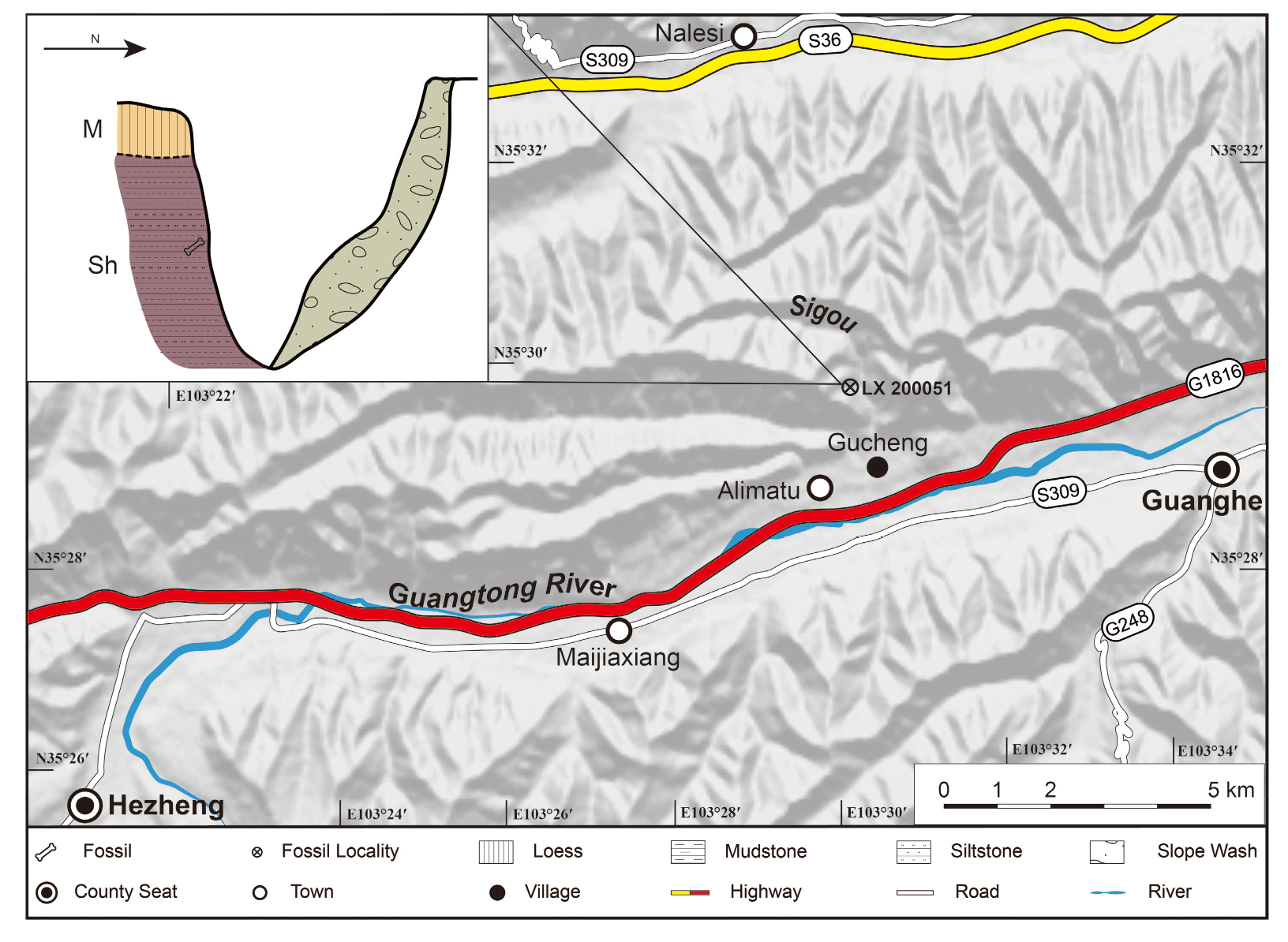
Fig. 1 Map showing the locality yielding micromammal fossils from the Shangzhuang Fm. in the Sigou gully of Guanghe County, Gansu Province M. Malan Loess; Sh. Shangzhuang Fm.
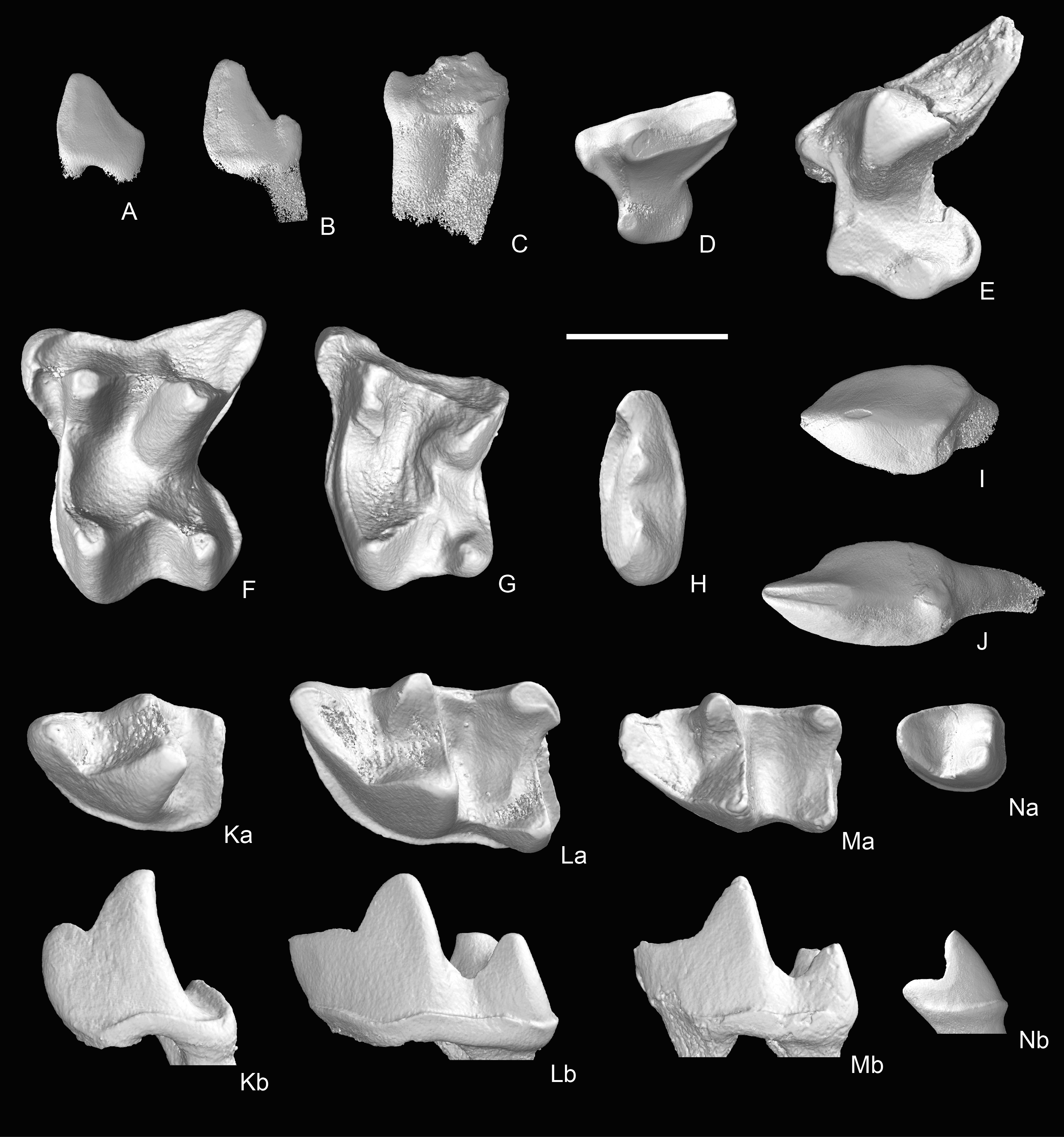
Fig. 2 Teeth of Amphechinus cf. A. minutissimus from Gucheng A. right I3 (IVPP V32986.2, reverse); B. left C (V32986.4); C. right P2 (V32986.7, reverse); D. right P3 (V32986.8, reverse); E. right P4 (V32986.16, reverse); F. right M1 (V32986.34, reverse); G. left M2 (V32986.52); H. left M3 (V32986.92); I. right i3 (V32986.95, reverse); J. right c (V32986.97, reverse); K. right p4 (V32986.110. reverse); L. right m1 (V32986. 127, reverse); M. right m2 (V32986.162, reverse); N. left m3 (V32986.184) A‒C, Kb‒Nb. lateral views; D‒J, Ka‒Na. occlusal views. Scale bar = 1 mm
| Tooth | Length | Width | ||||
|---|---|---|---|---|---|---|
| N | Range | Average | N | Range | Average | |
| I3 | 2 | 0.65 | 0.65 | 2 | 0.35‒0.40 | 0.38 |
| C | 3 | 0.60‒0.65 | 0.63 | 4 | 0.30‒0.40 | 0.36 |
| P2 | 1 | 0.75 | 0.75 | 1 | 0.40 | 0.40 |
| P3 | 3 | 0.90‒1.00 | 0.97 | 3 | 0.70‒0.80 | 0.77 |
| P4 | 4 | 1.35‒1.65 | 1.50 | 1 | 1.35 | 1.35 |
| M1 | 10 | 1.40‒1.70 | 1.51 | 10 | 1.50‒1.70 | 1.63 |
| M2 | 28 | 0.90‒1.40 | 1.12 | 27 | 1.35‒1.85 | 1.47 |
| M3 | 3 | 0.45‒0.55 | 0.50 | 3 | 1.10‒1.15 | 1.12 |
| i3 | 2 | 1.00‒1.10 | 1.05 | 2 | 0.55‒0.70 | 0.63 |
| c | 5 | 1.00‒1.10 | 1.07 | 5 | 0.50‒0.60 | 0.54 |
| p4 | 9 | 1.00‒1.15 | 1.10 | 12 | 0.65‒0.80 | 0.72 |
| dp4 | 1 | 1.20 | 1.20 | 1 | 0.90 | 0.90 |
| m1 | 9 | 1.60‒1.70 | 1.65 | 18 | 1.05‒1.25 | 1.13 |
| m2 | 16 | 1.15‒1.45 | 1.25 | 28 | 0.70‒1.05 | 0.85 |
| m3 | 5 | 0.55‒0.65 | 0.59 | 5 | 0.40‒0.50 | 0.47 |
Table 1 Measurements of teeth of Amphechinus cf. A. minutissimus from Gucheng, Linxia basin (mm)
| Tooth | Length | Width | ||||
|---|---|---|---|---|---|---|
| N | Range | Average | N | Range | Average | |
| I3 | 2 | 0.65 | 0.65 | 2 | 0.35‒0.40 | 0.38 |
| C | 3 | 0.60‒0.65 | 0.63 | 4 | 0.30‒0.40 | 0.36 |
| P2 | 1 | 0.75 | 0.75 | 1 | 0.40 | 0.40 |
| P3 | 3 | 0.90‒1.00 | 0.97 | 3 | 0.70‒0.80 | 0.77 |
| P4 | 4 | 1.35‒1.65 | 1.50 | 1 | 1.35 | 1.35 |
| M1 | 10 | 1.40‒1.70 | 1.51 | 10 | 1.50‒1.70 | 1.63 |
| M2 | 28 | 0.90‒1.40 | 1.12 | 27 | 1.35‒1.85 | 1.47 |
| M3 | 3 | 0.45‒0.55 | 0.50 | 3 | 1.10‒1.15 | 1.12 |
| i3 | 2 | 1.00‒1.10 | 1.05 | 2 | 0.55‒0.70 | 0.63 |
| c | 5 | 1.00‒1.10 | 1.07 | 5 | 0.50‒0.60 | 0.54 |
| p4 | 9 | 1.00‒1.15 | 1.10 | 12 | 0.65‒0.80 | 0.72 |
| dp4 | 1 | 1.20 | 1.20 | 1 | 0.90 | 0.90 |
| m1 | 9 | 1.60‒1.70 | 1.65 | 18 | 1.05‒1.25 | 1.13 |
| m2 | 16 | 1.15‒1.45 | 1.25 | 28 | 0.70‒1.05 | 0.85 |
| m3 | 5 | 0.55‒0.65 | 0.59 | 5 | 0.40‒0.50 | 0.47 |
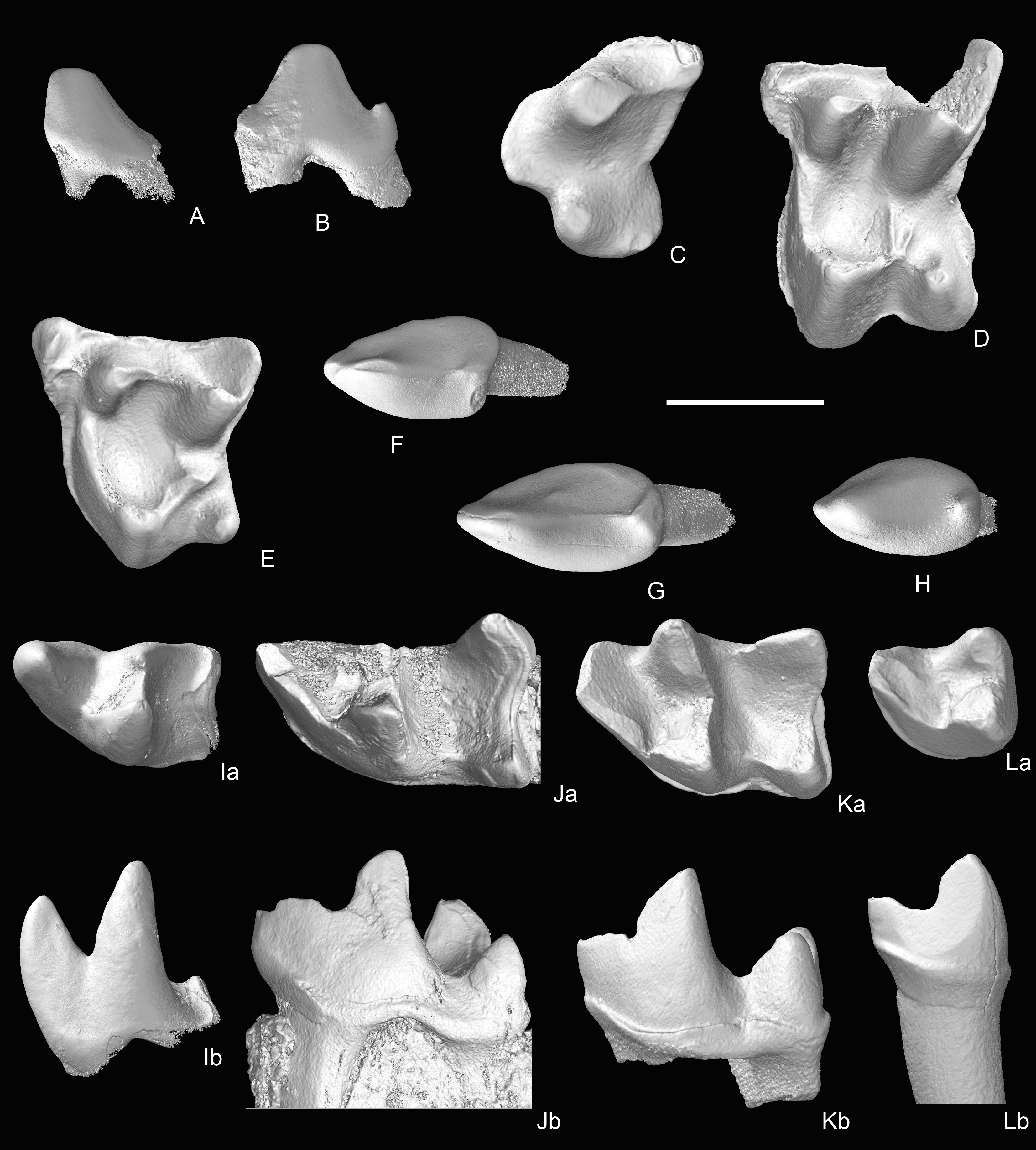
Fig. 3 Teeth of “Mioechinus” cf. “M.” gobiensis from Gucheng A. left I3 (IVPP V32987.2); B. right P2 (V32987.3, reverse); C. left P3 (V32987.5); D. right M1 (V32987.13, reverse); E. right M2 (V32987.18, reverse); F. right i3 (V32987.24, reverse); G. left c (V32987.25); H. right p2 (V32987.35, reverse); I. right p4 (V32987.40, reverse); J. left mandibular fragment with m1 (V32987.41); K. left m2 (V32987.53); L. left m3 (V32987.66) A‒B, Ib‒Lb. lateral views; C‒H, Ia‒La. occlusal views. Scale bar = 1 mm
| Tooth | Length | Width | ||||
|---|---|---|---|---|---|---|
| N | Range | Average | N | Range | Average | |
| I3 | 1 | 0.75 | 0.75 | 1 | 0.50 | 0.50 |
| P2 | 1 | 1.25 | 1.25 | 1 | 0.50 | 0.50 |
| P3 | 1 | 1.25 | 1.30 | 1 | 1.00 | 1.00 |
| M1 | 1 | 1.85 | 1.85 | 1 | 2.20 | 2.20 |
| M2 | 2 | 1.20‒1.55 | 1.38 | 3 | 1.85‒2.10 | 1.95 |
| i3 | 1 | 1.30 | 1.30 | 1 | 0.75 | 0.75 |
| c | 4 | 1.30‒1.40 | 1.36 | 4 | 0.65‒0.75 | 0.69 |
| p2 | 7 | 1.05‒1.20 | 1.11 | 7 | 0.55‒0.70 | 0.63 |
| p4 | 3 | 1.45‒1.60 | 1.53 | 3 | 0.90‒1.00 | 0.95 |
| dp4 | 1 | 1.50 | 1.50 | 0 | ‒ | ‒ |
| m1 | 1 | 2.15 | 2.15 | 7 | 1.30‒1.50 | 1.44 |
| m2 | 2 | 1.70‒180 | 1.85 | 11 | 0.95‒1.30 | 1.14 |
| m3 | 8 | 0.75‒0.85 | 0.79 | 8 | 0.60‒0.75 | 0.67 |
Table 2 Measurements of teeth of “Mioechinus” cf. “M.” gobiensis from Gucheng (mm)
| Tooth | Length | Width | ||||
|---|---|---|---|---|---|---|
| N | Range | Average | N | Range | Average | |
| I3 | 1 | 0.75 | 0.75 | 1 | 0.50 | 0.50 |
| P2 | 1 | 1.25 | 1.25 | 1 | 0.50 | 0.50 |
| P3 | 1 | 1.25 | 1.30 | 1 | 1.00 | 1.00 |
| M1 | 1 | 1.85 | 1.85 | 1 | 2.20 | 2.20 |
| M2 | 2 | 1.20‒1.55 | 1.38 | 3 | 1.85‒2.10 | 1.95 |
| i3 | 1 | 1.30 | 1.30 | 1 | 0.75 | 0.75 |
| c | 4 | 1.30‒1.40 | 1.36 | 4 | 0.65‒0.75 | 0.69 |
| p2 | 7 | 1.05‒1.20 | 1.11 | 7 | 0.55‒0.70 | 0.63 |
| p4 | 3 | 1.45‒1.60 | 1.53 | 3 | 0.90‒1.00 | 0.95 |
| dp4 | 1 | 1.50 | 1.50 | 0 | ‒ | ‒ |
| m1 | 1 | 2.15 | 2.15 | 7 | 1.30‒1.50 | 1.44 |
| m2 | 2 | 1.70‒180 | 1.85 | 11 | 0.95‒1.30 | 1.14 |
| m3 | 8 | 0.75‒0.85 | 0.79 | 8 | 0.60‒0.75 | 0.67 |
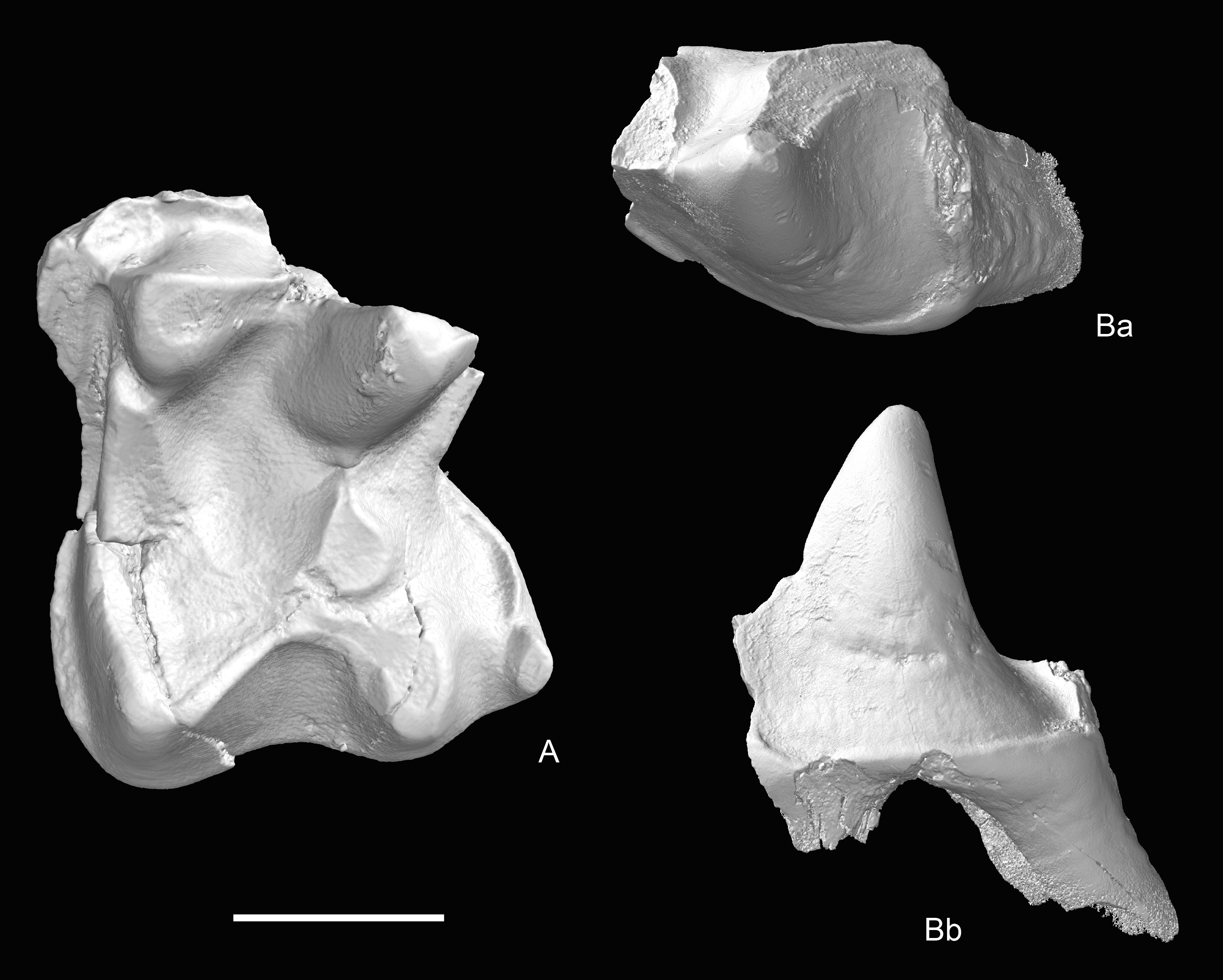
Fig. 4 Cheek teeth of Erinaceinae gen.et sp. indet. from Gucheng A. right M1 (IVPP V32988.3, reverse); B. left p4 (V32988.5); A, Ba. occlusal views; Bb. lateral view Scale bar = 1 mm
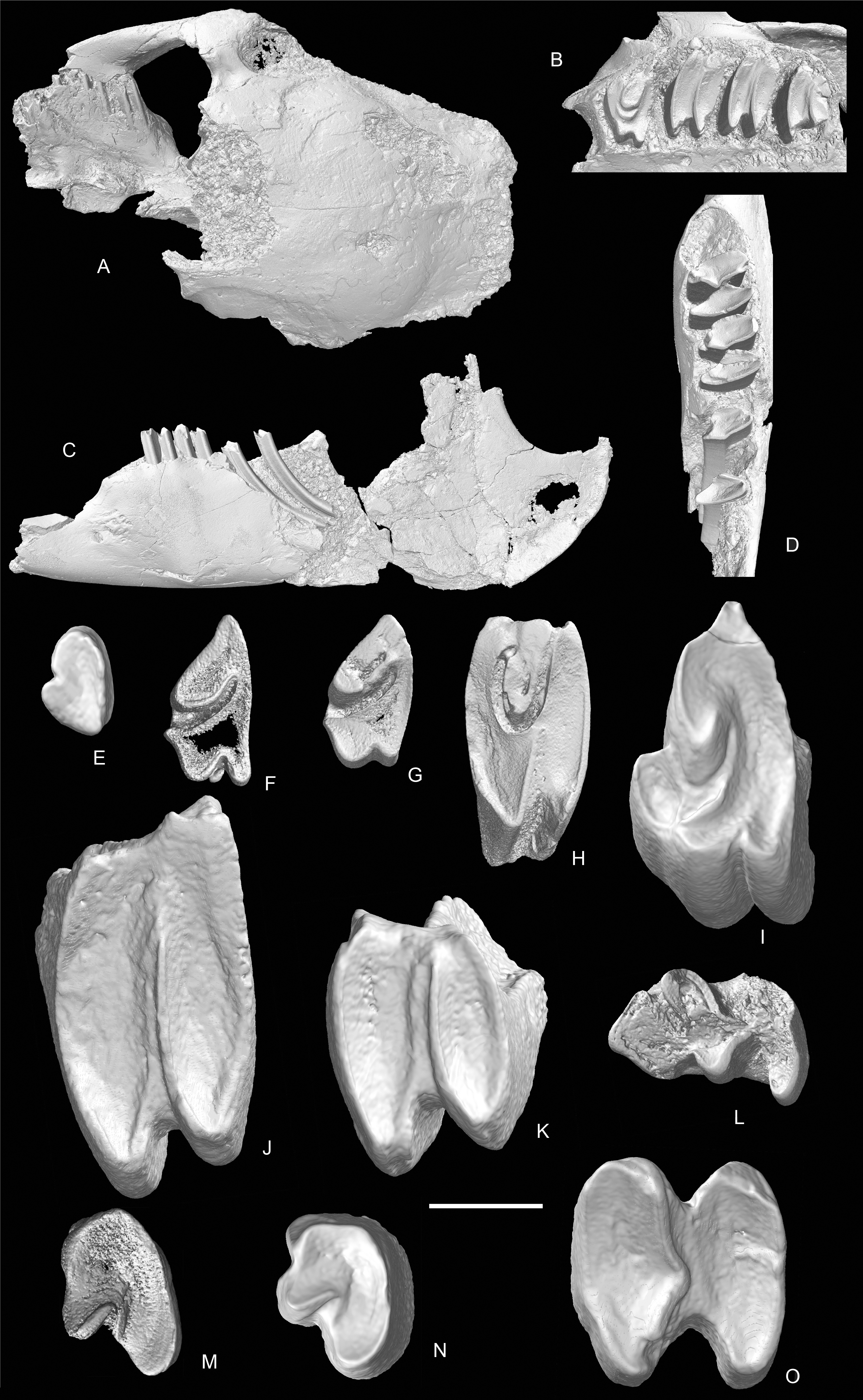
Fig. 5 Fragmentary skull, mandible and cheek teeth of Sinolagomys guchengensis from Gucheng A, B. damaged skull with right P3‒M2 (IVPP V32989.1, holotype; B. reverse); C, D. left mandibular fragment with p4‒m2 (V32989.2, paratype); E. left P2 (V32989.4);F. left DP3 (V32989.6); G. right DP3 (V32989.8, reverse); H. right DP4 (V32989.9, reverse);I. left P3 (V32989.10); J. right P4/M1 (V32989.42, reverse); K. right M2 (V32989.63, reverse);L. right dp3 (V32989.64, reverse); M. left p3 (V32989.66);N. right p3 (V32989.70, reverse); O. left p4/m1/m2 (V32989.72) A. dorsal view; C. buccal view; others. occlusal views Scale bars, for A, C = 8 mm; for B, D = 4 mm; for E‒O = 1 mm
| Tooth | Length | Width | ||||
|---|---|---|---|---|---|---|
| N | Range | Average | N | Range | Average | |
| P3‒M2 | 1 | 8.10 | ||||
| P4‒M2 | 1 | 5.80 | ||||
| M1‒M2 | 1 | 3.80 | ||||
| P2 | 2 | 0.60‒0.70 | 0.65 | 2 | 0.90‒1.20 | 1.05 |
| DP3 | 3 | 0.70 | 0.70 | 3 | 1.00‒1.40 | 1.20 |
| P3 | 20 | 1.20‒1.70 | 1.48 | 20 | 2.00‒2.90 | 2.40 |
| DP4 | 1 | 1.20 | 1 | 1.90 | ||
| P4/M1 | 28 | 1.00‒1.90 | 1.56 | 27 | 2.00‒3.30 | 2.67 |
| M2 | 9 | 1.20‒1.60 | 1.44 | 9 | 2.00‒2.80 | 2.48 |
| p3 | 7 | 1.00‒1.10 | 1.03 | 7 | 1.40‒1.60 | 1.50 |
| p4/m1/2 | 7 | 1.50‒2.20 | 1.97 | 7 tr. W | 1.50‒2.10 | 1.91 |
| 6 ta. W | 2.00‒2.20 | 2.12 | ||||
Table 3 Measurements of cheek teeth of Sinolagomys guchengensis from Gucheng (mm)
| Tooth | Length | Width | ||||
|---|---|---|---|---|---|---|
| N | Range | Average | N | Range | Average | |
| P3‒M2 | 1 | 8.10 | ||||
| P4‒M2 | 1 | 5.80 | ||||
| M1‒M2 | 1 | 3.80 | ||||
| P2 | 2 | 0.60‒0.70 | 0.65 | 2 | 0.90‒1.20 | 1.05 |
| DP3 | 3 | 0.70 | 0.70 | 3 | 1.00‒1.40 | 1.20 |
| P3 | 20 | 1.20‒1.70 | 1.48 | 20 | 2.00‒2.90 | 2.40 |
| DP4 | 1 | 1.20 | 1 | 1.90 | ||
| P4/M1 | 28 | 1.00‒1.90 | 1.56 | 27 | 2.00‒3.30 | 2.67 |
| M2 | 9 | 1.20‒1.60 | 1.44 | 9 | 2.00‒2.80 | 2.48 |
| p3 | 7 | 1.00‒1.10 | 1.03 | 7 | 1.40‒1.60 | 1.50 |
| p4/m1/2 | 7 | 1.50‒2.20 | 1.97 | 7 tr. W | 1.50‒2.10 | 1.91 |
| 6 ta. W | 2.00‒2.20 | 2.12 | ||||
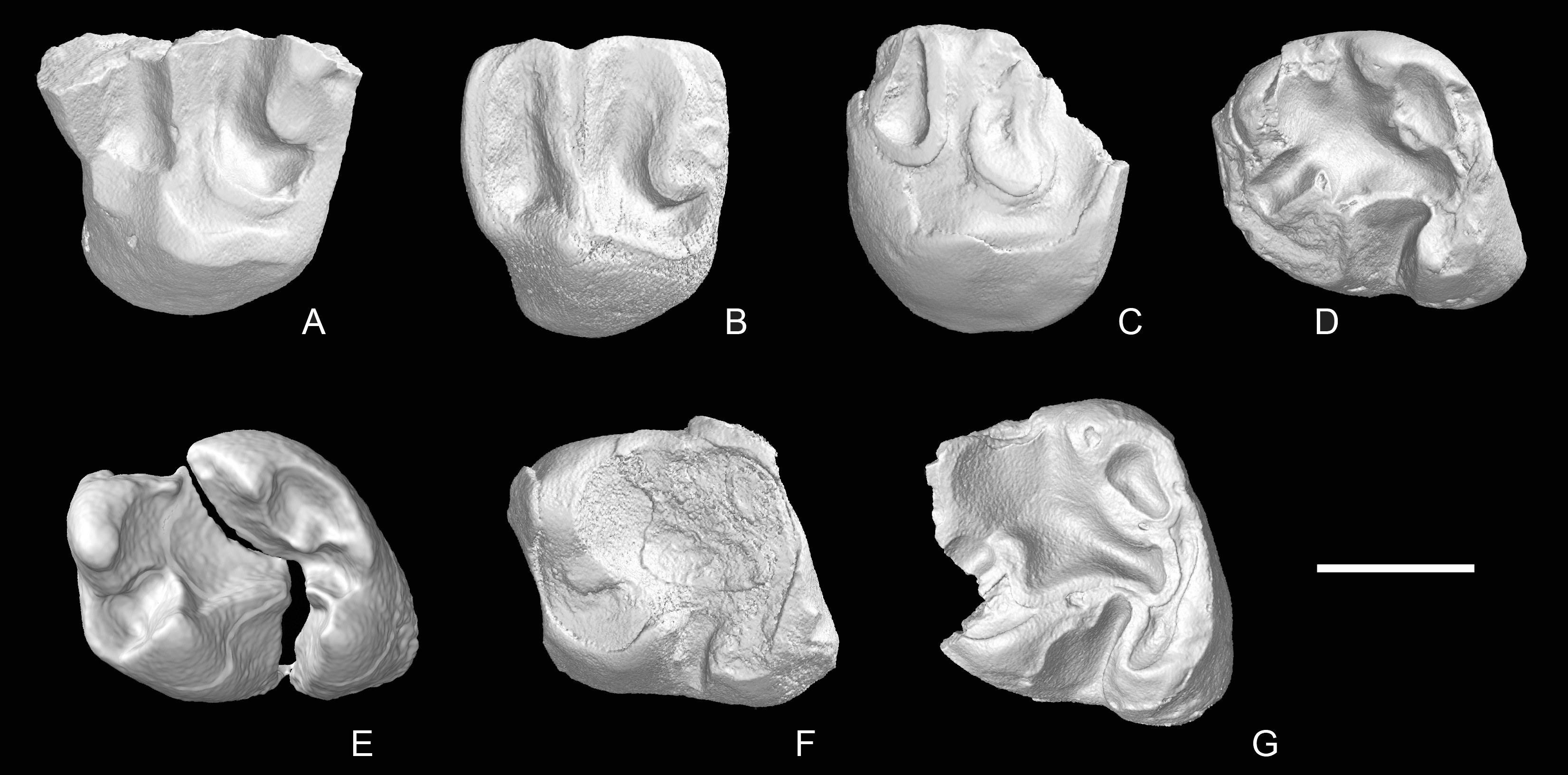
Fig. 6 Cheek teeth of Atlantoxerus orientalis from Gucheng in occlusal views A. right P4 (IVPP V31322.1, reverse); B. right M1/2 (V31322.3, reverse); C. right M1/2 (V31322.4, reverse); D. right m1/2 (V31322.7, reverse); E. left m1/2 (V31322.5); F. right m1/2 (V31322.8, reverse);G. right m1/2 (V31322.9, reverse). Scale bar = 1 mm

Fig. 7 Molars of Parasminthus sp. from Gucheng in occlusal views A. right M2 (IVPP V32990.1, reverse); B. right M3 (V32990.2, reverse), C. right m1 (V32990.3, reverse), D. right m3 (V32990.4, reverse). scale bar = 1 mm

Fig. 8 Molars of Litodonomys minimus from Gucheng in occlusal views A. left M1 (IVPP V32991.1); B. left M1 (V32991.10); C. right M1 (V32991.60); D. right M1 (V32991.89);E. left M2 (V32991.119); F. right M2 (V32991.132); G. left M3 (V32991.173); H. right M3 (V32991.198);I. left m1 (V32991.214); J. right m1 (V32991.260); K. left m2 (V32991.315); L. right m2 (V32991.333);M. left m3 (V32991.385); N. right m3 (V32991.404). Scale bar = 1 mm
| Tooth | Length | Width | ||||
|---|---|---|---|---|---|---|
| N | Range | Average | N | Range | Average | |
| M1 | 30 | 1.06‒1.25 | 1.18 | 30 | 0.95‒1.10 | 0.99 |
| M2 | 30 | 0.95‒1.20 | 1.05 | 30 | 0.85‒1.05 | 0.96 |
| M3 | 22 | 0.55‒0.66 | 0.60 | 22 | 0.60‒0.75 | 0.70 |
| m1 | 30 | 1.03‒1.25 | 1.14 | 30 | 0.72‒0.85 | 0.80 |
| m2 | 30 | 0.98‒1.15 | 1.08 | 30 | 0.84‒1.10 | 0.91 |
| m3 | 22 | 0.67‒0.75 | 0.71 | 22 | 0.67‒0.75 | 0.72 |
Table 4 Measurements of cheek teeth of Litodonomys minimus from Gucheng (mm)
| Tooth | Length | Width | ||||
|---|---|---|---|---|---|---|
| N | Range | Average | N | Range | Average | |
| M1 | 30 | 1.06‒1.25 | 1.18 | 30 | 0.95‒1.10 | 0.99 |
| M2 | 30 | 0.95‒1.20 | 1.05 | 30 | 0.85‒1.05 | 0.96 |
| M3 | 22 | 0.55‒0.66 | 0.60 | 22 | 0.60‒0.75 | 0.70 |
| m1 | 30 | 1.03‒1.25 | 1.14 | 30 | 0.72‒0.85 | 0.80 |
| m2 | 30 | 0.98‒1.15 | 1.08 | 30 | 0.84‒1.10 | 0.91 |
| m3 | 22 | 0.67‒0.75 | 0.71 | 22 | 0.67‒0.75 | 0.72 |
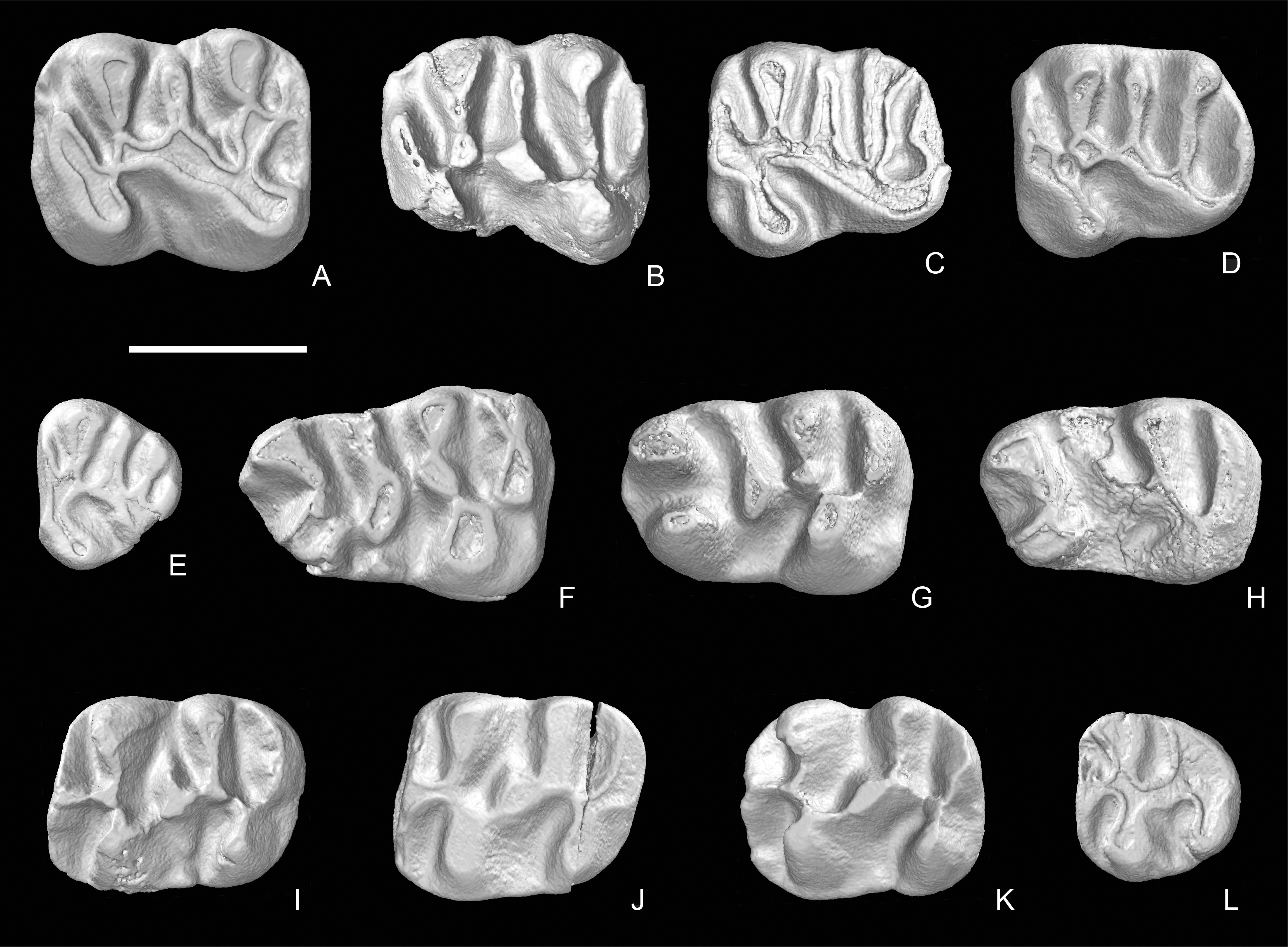
Fig. 9 Molars of Litodonomys zayssanensis from Gucheng in occlusal views A. left M1 (IVPP V32992.1); B. right M1 (V32992.7, reverse); C. left M2 (V32992.10);D. right M2 (V32992.16, reverse); E. left M3 (V32992.20); F. left m1 (V32992.23);G. right m1 (V32992.32, reverse); H. right m1 (V32992.41, reverse); I. left m2 (V32992.45);J. right m2 (V32992.55, reverse); K. right m2 (V32992.59, reverse); L. left m3 (V32992.61) Scale bar = 1 mm
| Tooth | Length | Width | ||||
|---|---|---|---|---|---|---|
| N | Range | Average | N | Range | Average | |
| M1 | 5 | 1.45‒1.50 | 1.47 | 6 | 1.18‒1.29 | 1.23 |
| M2 | 5 | 1.24‒1.40 | 1.35 | 6 | 1.05‒1.31 | 1.21 |
| M3 | 4 | 0.70‒0.95 | 0.86 | 4 | 0.90‒1.05 | 0.96 |
| m1 | 13 | 1.40‒1.65 | 1.50 | 16 | 0.90‒1.10 | 1.00 |
| m2 | 11 | 1.25‒1.45 | 1.37 | 12 | 1.10‒1.22 | 1.14 |
| m3 | 9 | 0.85‒1.00 | 0.93 | 9 | 0.82‒1.00 | 0.91 |
Table 5 Measurements of cheek teeth of Litodonomys zayssanensis from Gucheng (mm)
| Tooth | Length | Width | ||||
|---|---|---|---|---|---|---|
| N | Range | Average | N | Range | Average | |
| M1 | 5 | 1.45‒1.50 | 1.47 | 6 | 1.18‒1.29 | 1.23 |
| M2 | 5 | 1.24‒1.40 | 1.35 | 6 | 1.05‒1.31 | 1.21 |
| M3 | 4 | 0.70‒0.95 | 0.86 | 4 | 0.90‒1.05 | 0.96 |
| m1 | 13 | 1.40‒1.65 | 1.50 | 16 | 0.90‒1.10 | 1.00 |
| m2 | 11 | 1.25‒1.45 | 1.37 | 12 | 1.10‒1.22 | 1.14 |
| m3 | 9 | 0.85‒1.00 | 0.93 | 9 | 0.82‒1.00 | 0.91 |
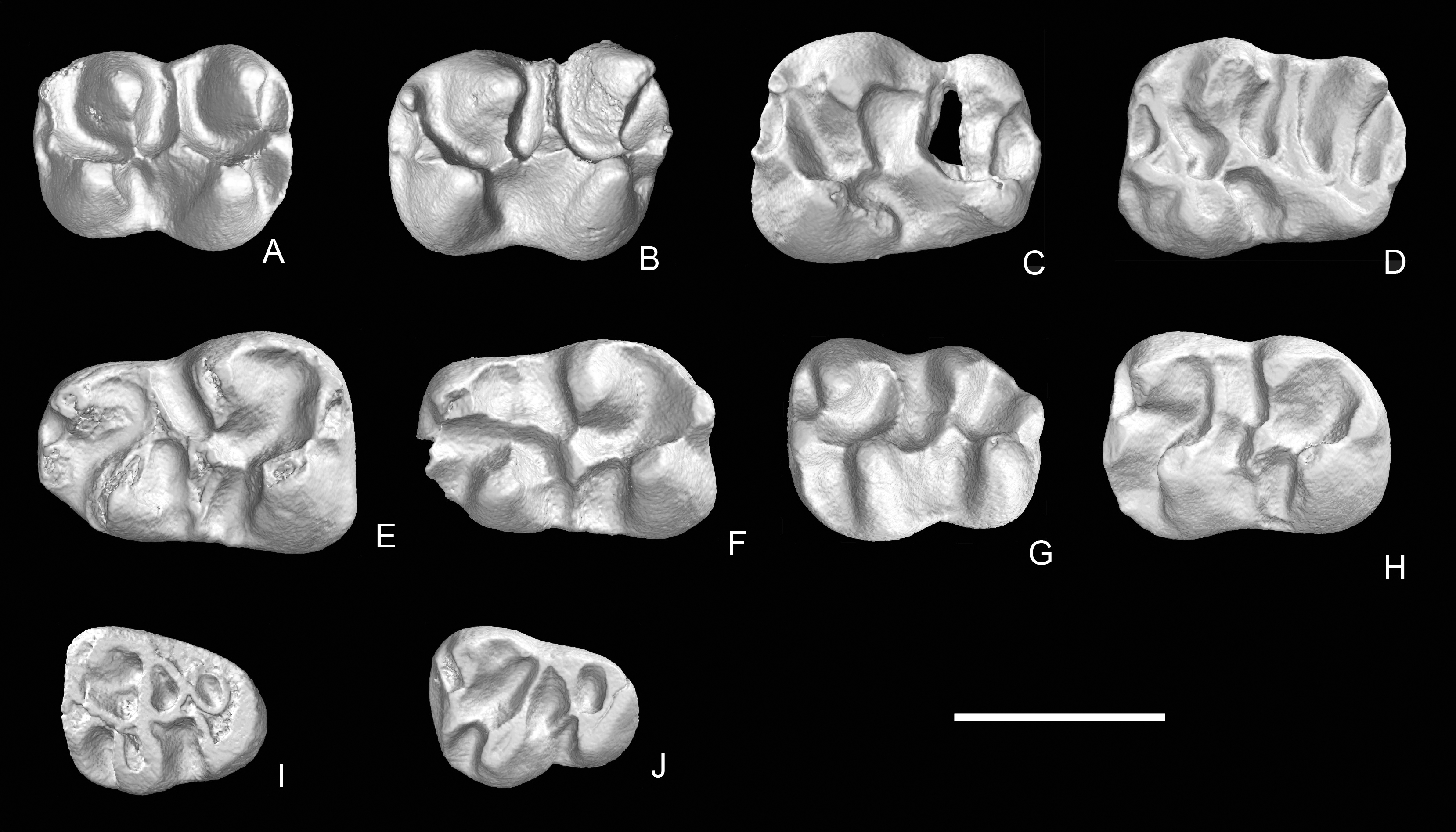
Fig. 10 Molars of Heterosminthus intermedius from Gucheng in occlusal views A. left M1 (IVPP V32994.3); B. right M1 (V32994.9, reverse); C. left M2 (V32994.13);D. right M2 (V32994.14, reverse); E. right m1 (V32994.21, reverse); F. right m1 (V32994. 23, reverse);G. left m2 (V32994.24); H. right m2 (V32994.31, reverse); I. left m3 (V32994.38);J. right m3 (V32994.39, reverse). Scale bar = 1 mm
| Tooth | Length | Width | Width/Length | ||||||
|---|---|---|---|---|---|---|---|---|---|
| N | Range | Average | N | Range | Average | N | Range | Average | |
| M1 | 12 | 1.15‒1.60 | 1.39 | 11 | 0.80‒1.25 | 1.10 | 11 | 0.70‒0.86 | 0.79 |
| M2 | 5 | 1.25‒1.40 | 1.31 | 5 | 0.91‒1.31 | 1.01 | 5 | 0.73‒0.81 | 0.77 |
| m1 | 3 | 1.20‒1.51 | 1.40 | 5 | 0.90‒1.06 | 0.98 | 3 | 0.61‒0.71 | 0.67 |
| m2 | 11 | 1.25‒1.48 | 1.34 | 11 | 0.85‒1.05 | 0.98 | 11 | 0.65‒0.80 | 0.73 |
| m3 | 2 | 1.00 | 1.00 | 2 | 0.75‒0.80 | 0.78 | 2 | 0.75‒0.80 | 0.78 |
Table 6 Measurements of cheek teeth of Heterosminthus intermedius from Gucheng (mm)
| Tooth | Length | Width | Width/Length | ||||||
|---|---|---|---|---|---|---|---|---|---|
| N | Range | Average | N | Range | Average | N | Range | Average | |
| M1 | 12 | 1.15‒1.60 | 1.39 | 11 | 0.80‒1.25 | 1.10 | 11 | 0.70‒0.86 | 0.79 |
| M2 | 5 | 1.25‒1.40 | 1.31 | 5 | 0.91‒1.31 | 1.01 | 5 | 0.73‒0.81 | 0.77 |
| m1 | 3 | 1.20‒1.51 | 1.40 | 5 | 0.90‒1.06 | 0.98 | 3 | 0.61‒0.71 | 0.67 |
| m2 | 11 | 1.25‒1.48 | 1.34 | 11 | 0.85‒1.05 | 0.98 | 11 | 0.65‒0.80 | 0.73 |
| m3 | 2 | 1.00 | 1.00 | 2 | 0.75‒0.80 | 0.78 | 2 | 0.75‒0.80 | 0.78 |
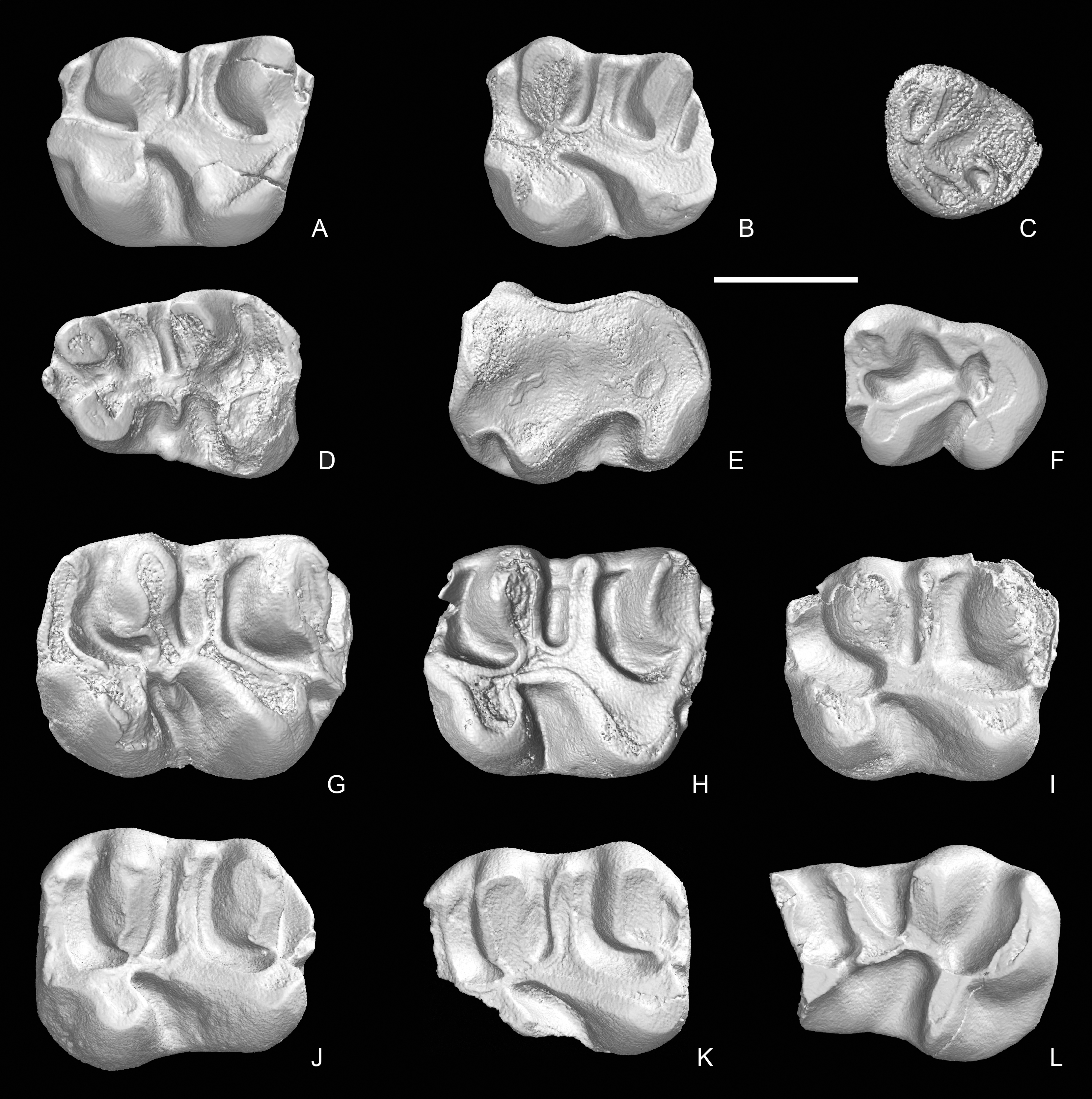
Fig. 11 Molars of Protalactaga grabaui (A‒F) and P. major (G‒L) from Gucheng in occlusal views A. right M1 (IVPP V32995.1, reverse); B. right M2 (V32995.2, reverse);C. left M3 (V32995.3); D. left m1 (V32995.4); E. left m2 (V32995.6); F. left m3 (V32995.8);G. left M1 (V32996.1); H. right M1 (V32996.3, reverse); I. right M1 (V32996.4, reverse);J. right M2 (V32996.5, reverse); K. right M2 (V32996.6, reverse); L. right m1 (V32996.7, reverse) Scale bar = 1 mm
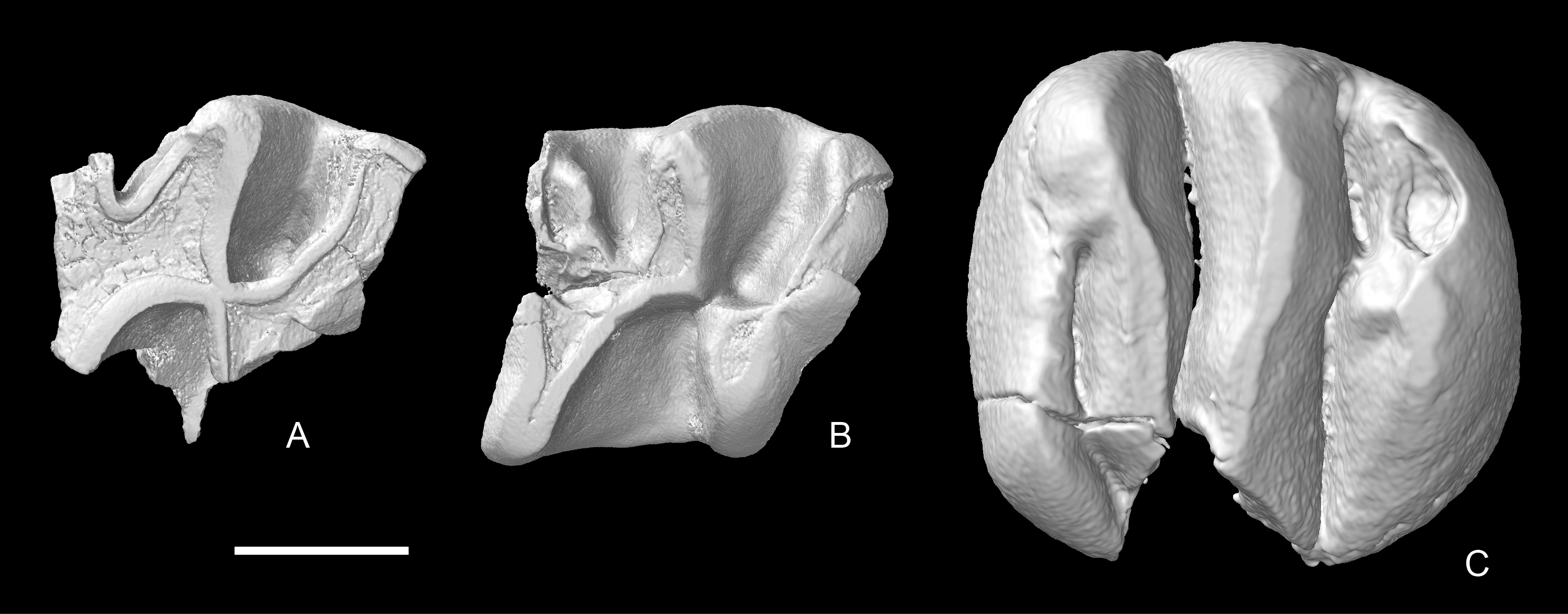
Fig. 12 Molars of Sayimys sp. (A, B) and Ayakozomys mandaltensis (C) from Gucheng in occlusal views A. damaged left m1/2 (IVPP V32997.1); B. damaged left m1/2 (V32997.2); C. left m2 (V33001) Scale bar = 1 mm
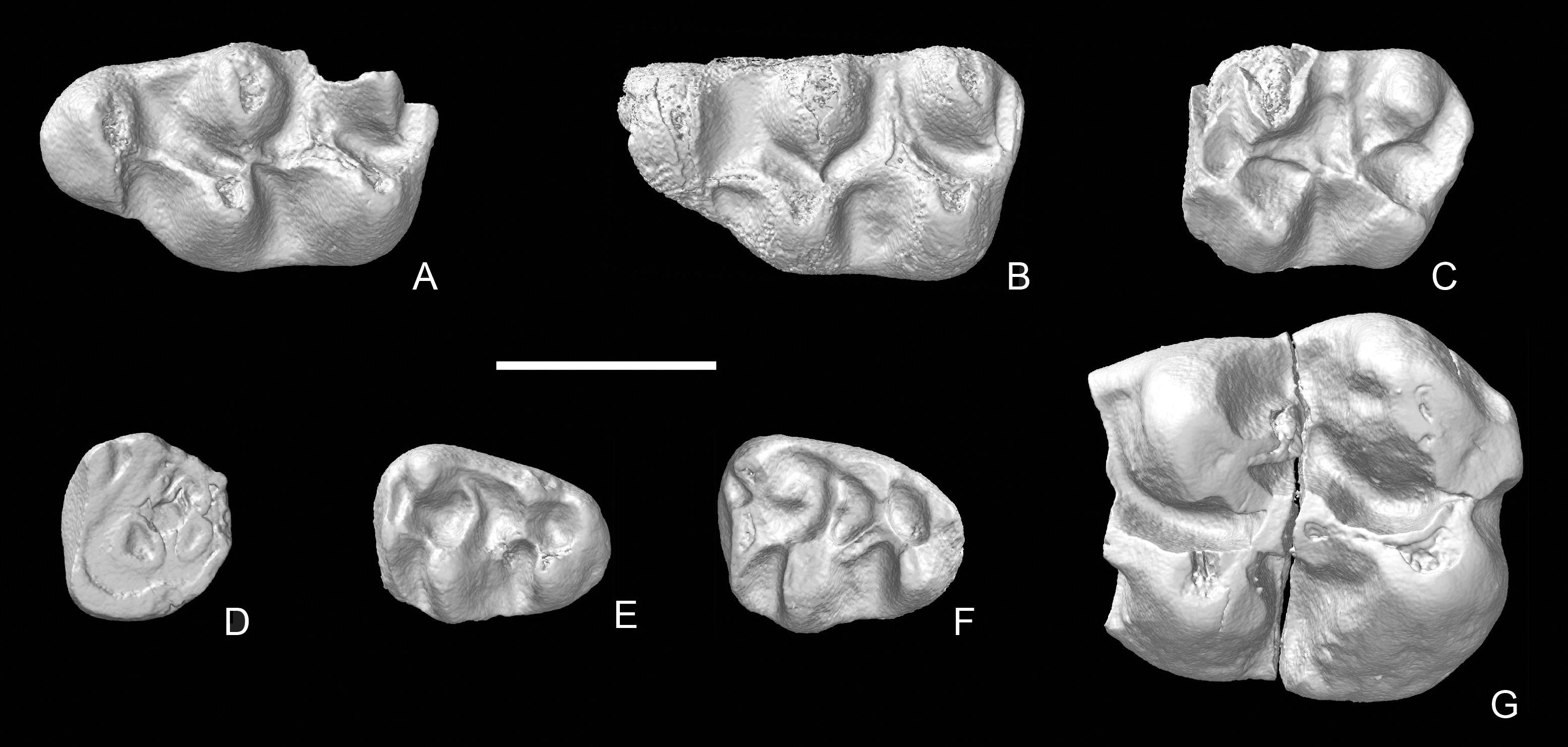
Fig. 13 Molars of Democricetodon sp. (A‒F) and Gobicricetodon flynni (G) from Gucheng in occlusal views A. left M1 (IVPP V32998.2); B. left M1 (V32998.1); C. left M2 (V32998.3); D. left M3 (V32998.5);E. left m3 (V32998.6); F. right m3 (V32998.7, reverse); G. left M1 (V33000) Scale bar = 1 mm
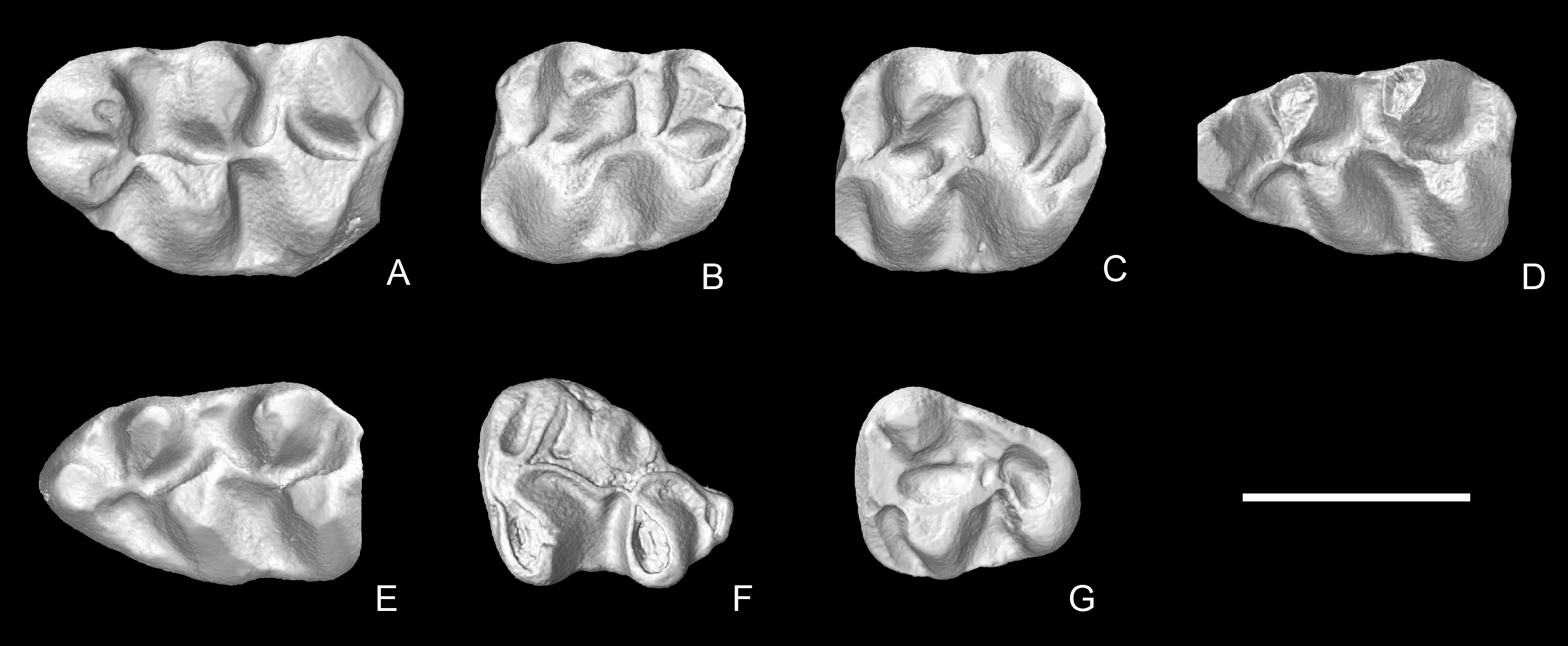
Fig. 14 Molars of Megacricetodon sinensis from Gucheng in occlusal views A. left M1 (IVPP V32999.1); B. right M2 (V32999.3, reverse); C. right M2 (V32999.4, reverse);D. left m1 (V32999.5); E. right m1 (V32999.6, reverse); F. right m2 (V32999.7, reverse); G. left m3 (V32999.10) Scale bar = 1 mm
| [1] | Bi S D, Wu W Y, Ye J et al., 1999. Erinaceidae from the Middle Miocene of North Junggar Basin, Xinjiang Uygur Autonomous Region, China. In: Wang Y Q, Deng T eds. Proceedings of the Seventh Annual Meeting of the Chinese Society of Vertebrate Paleontology. Beijing: China Ocean Press. 157-165 |
| [2] | Bohlin B, 1937. Oberoligozäne Säugetiere aus dem Shargaltein-Tal (Western Kansu). Palaeont Sin, New Ser C, 3: 1-66 |
| [3] | Bohlin B, 1942. The fossil mammals from the Tertiary deposit of Taben-buluk, Westetn Kansu. Part I: Insectivora and Lagomorpha. Palaeont Sin, New Ser C, 8a: 1-113 |
| [4] | Bohlin B, 1946. The fossil mammals from the Tertiary deposit of Taben-buluk, western Kansu. Part II: Simplicidentata, Carnivora, Artiodactyla, Perissodactyla, and Primates. Palaeont Sin, New Ser C, 8b: 1-259 |
| [5] | Butler P M, 1948. On the evolution of the skull and teeth in the Erinaceidae, with special reference on fossil material in British Museum. Proc Zool Soc London, 118: 446-500 |
| [6] | Chen W, Gao W, 2000. Cricetinae Fischer, 1817. In: Luo Z X, Chen W, Gao W et al. eds. Fauna Sinica. Vol 6, Part 3. Beijing: Science Press. 20-90 |
| [7] | Daxner-Höck G, Badamgarav D, 2007. Geological and stratigraphic setting. In: Daxner-Höck ed. Oligocene-Miocene Vertebrate from the Valley of Lakes (Central Mongolia): Morphology, Phylogenetic and Stratigraphic Implications. Ann Naturhist Mus Wien, 108A: 1-24 |
| [8] | Deng T, Qiu Z X, Wang B Y et al., 2013. Late Cenozoic Biostratigraphy of the Linxia Basin, Northwestern China. In: Wang X M, Flynn L J, Fortelius M eds. Fossil Mammal of Asia. New York: Columbia University Press. 243-273 |
| [9] |
Deng T, Hou S K, Wang S Q, 2019. Neogene integrative stratigraphy and timescale of China. Sci China Earth Sci, 62(1): 310-323
DOI |
| [10] | Erbajeva M, Daxner-Höck, 2014. The most prominent Lagomorpha from the Oligocene and Early Miocene of Mongolia. Ann Nathurhist Mus Wien, Ser A, 116: 215-245 |
| [11] | Erbajeva M, Baatarjav B, Daxner-Höck G et al., 2017. Occurrences of Sinolagomys (Lagomogpha) from the Valley of Lakes (Mongolia). Palaeobio Palaeornv, 97: 11-24 |
| [12] | Fahlbusch V, 1964. Die Cricetiden (Mammalia) der Oberen Süsswasser-Molasse Bayerns. Abh Bayer Akad Wiss, 118: 1-136 |
| [13] | Fang X M, Li J J, Wang J L et al., 1995. Records of the uplift of the Qinghai-Xizang (Tibetan) Plateau and long-term climate change. In: Li et al. eds. Lanzhou: Lanzhou University Press. 19-83 |
| [14] | Gomes Rodrigues H, Marivaux L, Vianey-Liaud M, 2012. The Cricetidae (Rodentia, Mammalia) from the Ulantatal area (Inner Mongolia, China): new data concerning the evolution of Asian cricetids during the Oligocene. J Asian Earth Sci, 56: 160-179 |
| [15] | Hinton M, 1933. Diagnosis of new genera and species of rodonts from Indian Tertiary deposits. Ann Mag Nat Hist, Ser 10, 12: 620-622 |
| [16] | Kimura Y, 2010. New material of dipodid rodents (Dipodidae, Rodentia) from the Early Miocene of Gashunyinadege, Nei Mongol, China. J Vert Paleont, 30(6): 1860-1873 |
| [17] | Li C K, 1965. Eocene leporids of North China. Vert PalAsiat, 9(1): 23-36 |
| [18] | Li C K, Qiu Z D, 1980. Early Miocene mammalian fossils of Xining Basin, Qinghai. Vert PalAsiat, 18(3): 198-214 |
| [19] | Li C K, Zhang Z Q, 2019. Order Lagomopha Brandt, 1855. In: Li C K, Zhang Z Q eds. Palaeovertebrata Sinica, Vol III, Fasc 4. Beijing: Science Press. 34-144 |
| [20] | Li L, 2021. The eulipotyphlans from the Early Miocene of central Nei Mongol. Ph. D thesis. Beijing: College of Earth and Planetary Sciences, University of Chinese Academy of Sciences. 1-185 |
| [21] | Lopatin A V, 2001. A new species of Heterosminthus (Dipodidae, Rodentia, Mammalia) from the Miocene of the Baikal Region. Paleont J, 35(2): 200-203 |
| [22] | Lopatin A V, Zazhigin V S, 2000. The history of the Dipodoidea (Rodentia, Mammalia) in the Miocene of Asia: 2. Zapodidae. Paleont J, 34(4): 449-454 |
| [23] | Lucas S G, Kordikova E G, Emry R J, 1998. Oligocene stratigraphy, sequence stratigraphy, and mammalian biochronology North of Aral Sea, western Kazakstan. In: Beard K C, Dawson M R eds. Dawn of the Age of Mammals in Asia. Bull Carnegie Mus Nat Hist, 34: 313-348 |
| [24] | Luo Z X, 1988. The Chinese Hare. Bejing: China Forestry Publishing House. 1-186 |
| [25] | Meng J, Ye J, Wu W Y et al., 2006. A recommended boundary stratotype section for Xiejia Stage from northern Junggar Basin: implications to related bio-chronostratigraphy and environmental changes. Vert PalAsiat, 44(3): 205-236 |
| [26] | Nowak R M, 1991. Walker’s Mammals of the World. 5th ed. Vols 1, 2. Baltimore: Johns Hopkins University Press. 1-1629 |
| [27] | Qiu Z D, 1996. Middle Miocene Micromammalian Fauna from Tunggur, Nei Mongol. Beijing: Science Press. 1-216 |
| [28] | Qiu Z D, 2010. Cricetid rodents from the Early Miocene Xiacaowan Formation, Sihong, Jiangsu. Vert PalAsiat, 48(1): 27-47 |
| [29] | Qiu Z D, 2019. Family Sciuridae Fischer von Waldheim, 1817. In: Li C K, Qiu Z D eds. Palaeovertebrata Sinica, Vol III, Fasc 5. Beijing: Science Press. 70-161 |
| [30] | Qiu Z D, Li Q, 2016. Neogene rodents from central Nei Mongol, China. Palaeont Sin New Ser C, 30: 1-684 |
| [31] | Qiu Z D, Qiu Z X, 2013. Early Miocene Xiejiahe and Sihong fossil localities and their faunas, eastern China. In: Wang X M, Flynn L, Fortelius M eds. Fossil Mammal of Asia. New York: Columbia University Press. 142-154 |
| [32] | Qiu Z D, Tong Y S, 2015. Order Eulipotyphla Waddell, Okada et Hasegawa, 1999. In: Li C K, Qiu Z D eds. Palaeovertebrata Sinica, Vol III, Fasc 3. Beijing: Science Press. 1-140 |
| [33] | Qiu Z D, Wang B Y, 2019. Family Dipodidae Fischer von Waldheim, 1817. In: Li C K, Qiu Z D eds. Palaeovertebrata Sinica, Vol III, Fasc 5(1). Beijing: Science Press. 242-326 |
| [34] | Qiu Z D, Li C K, Wang S J, 1981. Miocene mammalian fossils from Xining Basin, Qinghai. Vert PalAsiat, 19(2): 156-173 |
| [35] | Qiu Z D, Wang X M, Li Q, 2013. eogene faunal succession and biochrology of central Nei Mongol (Inner Mongolia). In: Wang X M, Flynn L, Fortelius M eds. Fossil Mammal of Asia. New York: Columbia University Press. 155-186 |
| [36] | Qiu Z D, Wang X M, Li Q et al., 2021. Late Miocene mammalian fauna of Halajin Hushu in Nei Mongol, China. Vert PalAsiat, 59(1): 19-44 |
| [37] | Qiu Z D, Wang B Y, Li L, 2023. Middle Cenozoic micromammals from Linxia Basin, Gansu Province, China, and their implications for biostratigraphy and palaeoecology. Palaeogeogr Palaeocli Palaeoecol, 616: 111467 |
| [38] | Qiu Z X, Qiu Z D, Deng T et al., 2013. Neogege land mammal stages/ages of China:toward the goal to establish an Asian land mammal stage/age scheme. In: Wang X M, Flynn L, Fortelius M eds. Fossil Mammal of Asia. New York: Columbia University Press. 29-90 |
| [39] | Qiu Z X, Qiu Z D, Zheng Y et al., 2023. Stratigraphic context of Oligocene to Pliocene mammal-bearing depositis in Linxia Basin, Gansu Province, China: a historical review and a discussion of ongoing controversies. Palaeogeogr Palaeocli Palaeoecol, 628: 111773 |
| [40] | Schaub S, 1930. Fossile Sicistinae. Eclogae Geol Helv, 23(2): 616-637 |
| [41] | Tong Y S, 1989. A new species of Sinolagomys (Lagomorpha, Ochotonidae) from Xinjiang. Vert PalAsiat, 27(2): 103-116 |
| [42] | Tyutkova L A, 2000. New Early Miocene Tachyoryctoididae (Rodentia, Mammalia) fom Kazakhstan. Selevinia, 1-4: 67-72 |
| [43] | Vinogradov B S, 1925. On the structure of the external genitalia in Dipodidae and Zapodidae (Rodentia) as a classificatory character. Proc Zool Soc London, 1: 572-582 |
| [44] |
Waddell P J, Okada N, Hasegawa M, 1999. Towawds resolving the interordinal relationships of placental mammals. Syst Biol, 48: 1-5
PMID |
| [45] | Wang B Y, 1997. The Mid-Tertiary Ctenodactylidae (Rodentia, Mammalia) of Eastern and Central Asia. Bull Am Mus Nat Hist, 234: 1-88 |
| [46] | Wang B Y, 2019. Family Ctenodactylidae Gervais, 1853. In: Li C K, Qiu Z D eds. Palaeovertebrata Sinica, Vol III, Fasc 5(1). Beijing: Science Press. 388-436 |
| [47] | Wang B Y, 2003. Dipodidae (Rodentia Mammalia) from the mid-Tertiary deposits in Danghe Area, Gansu, China. Vert PalAsiat, 41(2): 89-103 |
| [48] | Wang B Y, Qiu Z D, 2020. Family Spalacidae Gray, 1821. In: Li C K, Qiu Z D, Zheng S H eds. Palaeovertebrata Sinica. Vol III, Fasc 5(2). Beijing: Science Press. 228-264 |
| [49] | Wang B Y, Qiu Z X, 2000. Dipodidae (Rodentia, Mammalia) from the Lower Member of Xianshuihe Formation in Lanzhou Basin, Gansu, China. Vert PalAsiat, 38(1): 12-38 |
| [50] | Wang B Y, Wu W Y, Qiu Z D, 2000. Family Cricetidae Fischer von Waldheim, 1817. In: Li C K, Qiu Z D, Zheng S H eds. Palaeovertebrata Sinica. Vol III, Fasc 5(2). Beijing: Science Press. 10-152 |
| [51] | White J A, 1991. North American Leporinae (Mammalia: Lagomorpha) from Late Miocene (Clarendonian) to latest Pliocene (Blancan). J Vert Paleont, 14(1): 67-89 |
| [52] | Wood A E, 1937. Rodentia. In: Scott W B, Jepsen G L, Wood A E eds. The Mammalian Fauna of the White River Oligocene, Part II. Trans Am Phil Soc, New Ser, 28: 15500269 |
| [53] | Young C C, 1927. Fossil Nagetiere aus Nord-China. Paleont Sin, Ser C, 5(3): 1-82 |
| [54] | Zheng Y, Qiu Z X, Qiu Z D et al., 2023. Revised magnetostratigraphy of the Linxia Basin in the northeastern Tibetan Plateau, constrained by micromammalian fossils. Palaeogeogr Palaeocli Palaeoecol, 623: 111620 |
| [55] | Zhou M Z, Qiu Z X, Li C K, 1975. Some suggestions for unifying translation of nomenclature of the primaive eutherian molar-teeth. Vert PalAsiat, 13(4): 257-266 |
| [56] | Ziegler R, Dahlmann T, Storch G, 2007. 4. Marsupialia, Erinaceomorpha and Soricomorpha (Mammalia). In: Daxner-Höck G ed. Oligocene-Miocene Vertebrates from the Valley of Lakes (Central Mongolia): Morphology, Phylogenetic and Stratigraphic Implications. Ann Naturhist Mus Wien, 108A: 53-164 |
| [1] | WANG Ban-Yue, QIU Zhan-Xiang. Micromammal fossils from the basal part of the Jiaozigou Formation in Yagou area, Linxia Basin, Gansu Province . Vertebrata Palasiatica, 2023, 61(4): 284-316. |
| [2] | WANG Ban-Yue, QIU Zhan-Xiang, WANG Shi-Qi. Mansancun Micromammal Fauna from the upper part of the Jiaozigou Formation in Linxia Basin, Gansu Province . Vertebrata Palasiatica, 2023, 61(2): 123-141. |
| [3] | LI Yong-Xiang, HU Song-Mei , WANG She-Jiang , ZHANG Yun-Xiang. New materials of micromammal fossils from Longyadong Cave in Luonan Basin, Shaanxi, central China . Vertebrata Palasiatica, 2016, 54(4): 332-350. |
| [4] | CHEN Ping-Fu, LIU Huan-Zhang, YAN Ji-Xing. DISCOVERY OF FOSSIL COREOPERCA (PERCIFORMES) IN CHINA . Vertebrata Palasiatica, 1999, 37(03): 212-227. |
| Viewed | ||||||
|
Full text |
|
|||||
|
Abstract |
|
|||||